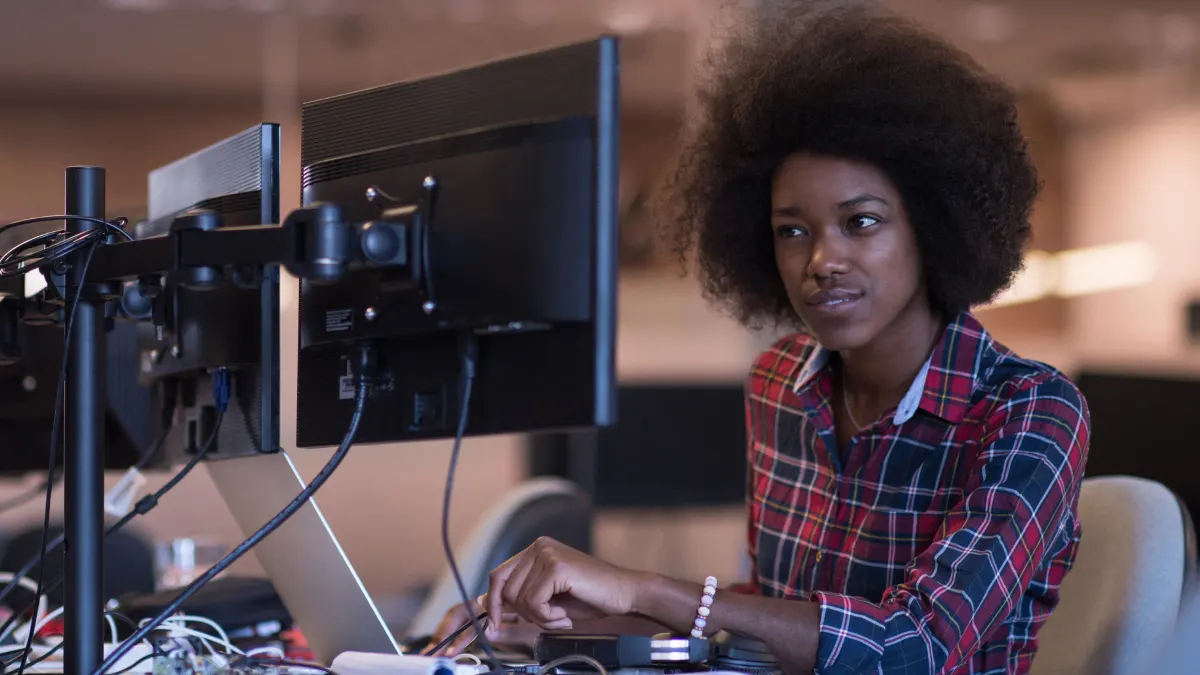MacBook Pro dual monitor setup: What you need to know

Is switching between windows slowing you down, or do you need more screen space to boost your productivity? Instead of working on just a single screen, a MacBook Pro dual monitor setup lets you connect two screens to one MacBook®.. But the setup process may be daunting if you’re considering a double display for the first time.
Don’t worry, though. At Asurion, we help millions of customers with their tech needs every day. From fixing MacBook Pro® screen flickering problems to resolving a Mac® detecting two monitors as one issue, our experts solve tech problems quickly and make things work the way they should. Here’s how to set up dual display on your MacBook Pro.
How to set up dual monitors with a MacBook Pro
Before you expand your workspace, verify that your MacBook Pro and monitors can work together.
1. Check your MacBook Pro's compatibility
Confirm that your MacBook Pro supports dual external displays. Most Intel-based MacBook Pros can handle two or more displays. But if you’re using an M1 or M2 MacBook Pro, confirm with Apple’s official specs. Some base models only support one external display unless you use a workaround like DisplayLink.
Also, check your MacBook Pro’s ports and capabilities. Newer models have USB-C or Thunderbolt™ 3/4 ports for external display. If you have a 2021 or newer 14-inch or 16-inch MacBook Pro with an M1 Pro, M1 Max, M2 Pro, or M2 Max chip, your device likely has a built-in HDMI® port. You can connect a display without an adapter.
2. Required hardware for the setup
Once you have confirmed your laptop’s specifications, find the right accessories to complete the MacBook Pro dual monitor setup:
- Two external monitors: You'll need two compatible monitors to create a dual display setup.
- External display connector: If your device doesn’t have an HDMI port, get a USB-C to HDMI adapter or Thunderbolt 3 to HDMI adapter. For monitors that support DisplayPort® input, use a USB-C to DisplayPort adapter.
- HDMI/DisplayPort cables: They’ll connect your external monitors to your MacBook Pro or the adapters.
- USB-C hub: It’s useful if your MacBook has limited ports.
3. Connecting the monitor
Here’s how you set up each MacBook Pro external monitor:
- Connect the first monitor to one of your MacBook Pro’s Thunderbolt 3 or USB-C ports using the appropriate adapter and cable.
- Repeat the process with the second monitor.
- Turn on the two monitors and your MacBook Pro. Your device should automatically detect the external displays.
Configuring the displays on macOS
After connecting your laptop to the two monitors, adjust your settings for the best experience with the MacBook Pro extended display.
1. Arrange your displays
Arrange your monitors to mimic your physical setup so your mouse and windows move naturally between screens:
- Click the Apple Menu.
- Select System Preferences > Displays > Arrangement.
- Drag and position the displays to match your monitors’ physical arrangement on your desk.
2. Set resolution and display preferences
You can adjust the resolution of each monitor to suit different needs, such as gaming, video editing, readability, and photo editing:
- Go to Apple Menu > System Preferences > Displays.
- Select the monitor you want to adjust the resolution for.
- Choose Default or Scaled resolution, depending on your preference.
3. Choosing the primary display
One of your two monitors will be the primary display, where the menu bar and dock appear by default. To change the main display, head to Apple Menu> System Preferences > Displays. Drag the white bar to the screen you want to set as your primary display.
Troubleshooting common issues
If you run into issues during the setup process, don’t worry. Here’s how to tackle common challenges.
Both monitors show the same thing
When both monitors show the same thing instead of working as separate workspaces, the displays are in mirror mode. To fix this:
- Head to Apple Menu> System Preferences > Displays.
- Select Arrangement.
- Uncheck Mirror Displays.
Monitors are not being detected
Check that all your connections to the MacBook Pro and monitors are secure. If the issue persists, try different ports to rule out potential port issues. If everything else fails, restart your laptop. A simple reboot can help your computer recognize new hardware.
FAQs
Can I connect three monitors to a MacBook Pro?
Yes, if your model supports it. Models like base M1 and M2 require a workaround to support multiple external monitors.
Do I need a Thunderbolt hub or docking station?
Only if you need extra ports or use a base model with limited outputs.
How do I switch between monitors quickly?
Use Mission Control. Press F3 or swipe up with three fingers on the trackpad to view all open windows. You can also drag windows between screens to move apps across monitors.
How do I make dual monitors not mirror each other on my Mac?
Go to System Preferences > Displays > Arrangement. Then uncheck Mirror Displays.
The Asurion® trademarks and logos are the property of Asurion, LLC. All rights reserved. All other trademarks are the property of their respective owners. Asurion is not affiliated with, sponsored by, or endorsed by any of the respective owners of the other trademarks appearing herein.
- SHARE THIS ARTICLE